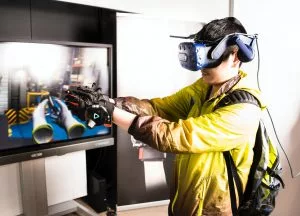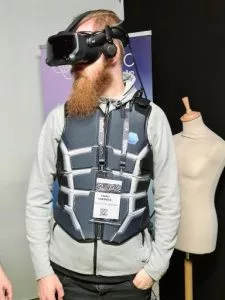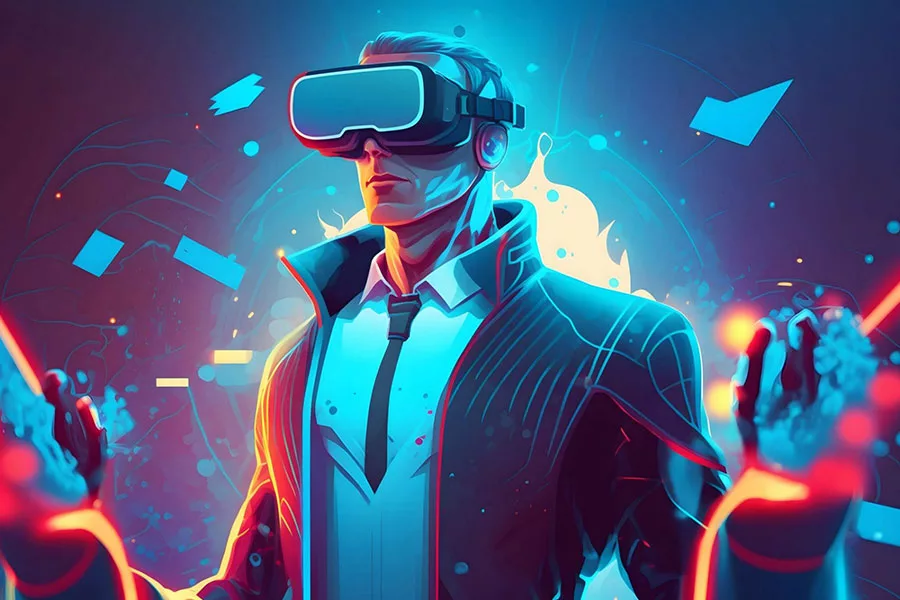As virtual reality experiences significant growth, including in professional training (referred to as immersive learning), new technologies continue to evolve to provide users with ever greater realism in their immersive experience. Among these technologies are haptic technologies. Our developers are here to help you gain a clearer understanding.
Gloves, suits, platforms… Haptic technology allows users to experience the sensation of touching virtual objects as if they were real, by sending physical signals such as pressure, texture, weight, resistance, and vibration. Haptics enhance user engagement in virtual reality by providing several benefits, including:
- Enhancement of immersion: The addition of tactile (touching a texture) and kinesthetic (weight, pressure, etc.) sensations amplifies the immersive experience by creating a sense of physical presence in the virtual environment.
- Real-time feedback: By perceiving these sensations, the user can know when they are interacting with virtual objects.
- Enhanced realism: Haptics add realism to virtual reality by allowing users to experience sensations similar to those they would feel in the real world.
- More natural interaction: Haptic technologies make interactions with virtual objects more natural. Users can touch, hold, and move objects as they would in the real world.
What is haptics?
By definition, haptics refers to the science of touch and kinesthetic phenomena, that is, the perception of the body within the environment.
In the field of innovation, haptics is a technology that provides users with a sense of touch by sending physical signals, usually through vibrations. This technology is used in a variety of applications, such as video game controllers, touch screens, flight simulators, and virtual reality devices (controllers, gloves, vests, etc.).
Applied to VR, haptics can include sensations of pressure, friction, resistance, weight, textures, and even temperatures.
The goal is to create a more immersive experience by giving the user the sensation of touching virtual objects as if they were truly real.
Technologies haptiques : où en est-on ?
Haptics is a field in constant evolution, with the emergence of new players and numerous innovations.
Here are some of the latest advancements in this field:
- Advanced haptic gloves: Haptic gloves allow users to perceive tactile sensations in their hands. Recent innovations have significantly improved their precision. Some advanced haptic gloves can now detect individual finger movements, providing better manipulation of objects in virtual environments.

- Haptic suits: Haptic suits allow for the reproduction of sensations across the entire body. Recent innovations in this field have led to the design of lighter, more comfortable, and more precise haptic suits in terms of movement and sensation reproduction.

- Haptic motion platforms: These devices allow users to experience swaying, vibration, or tilting movements. Haptic motion platforms are becoming increasingly smaller and more affordable.
- Augmented reality: Augmented reality involves overlaying virtual elements onto the physical world to create enhanced visual experiences. Haptic technology, on the other hand, enables users to experience tactile sensations (textures, pressures, etc.). By combining these two technologies, we can offer more immersive and interactive experiences. This allows users not only to see virtual elements in their environment but also to touch and physically feel them. This can have applications in various fields such as training, medicine, entertainment, industry, and more.
In summary, the latest innovations in haptic technology have led to the development of devices that are more precise, comfortable, affordable, and immersive. Their significant advancement suggests new possibilities for applications in fields such as video gaming, professional training, healthcare, and more.
Haptic technologies: the latest innovations seen at CES in Las Vegas
At the latest CES in Las Vegas, many haptic innovations were showcased. For example, the PlayStation VR2 features a lighter, more ergonomic VR headset with built-in 4K HDR screens, and it also includes embedded haptic technology that allows users to experience tactile sensations both in the controllers and the headset. Players can feel their character’s heartbeat accelerate or experience micro-vibrations when an object brushes past them.
In another realm, the company Raze has developed haptic chairs to enhance immersion while watching a movie or experiencing VR. The chair can tilt according to the action and offers seating with 65,000 different vibration levels. Other haptic innovations were also presented, whether still in concept stage or already on the market, such as Owo’s t-shirt that allows users to feel impacts and blows received during a game, or Razor’s soundbar capable of creating a sound bubble.
Haptics at Audace: The Bridgestone Case!
Bridgestone, a tire manufacturer, aimed to train new production line operators in the specific tasks of their job and to effectively prepare them for real working conditions. To meet this need, Audace recreated a complete production line and its various machines in virtual reality. The operator navigates a virtual environment using a VR treadmill. Haptic gloves enable them to perform all the necessary tasks for tire assembly, acquire precise technical skills, and learn how to monitor control points. These gloves also allow the operator to feel the effects of the tire they are handling on their own hands, as if in reality, enhancing the retention of the technique by activating muscle memory.
To conclude
Haptic technology is constantly advancing. Versatile and multi-sectoral, it provides a more immersive and realistic experience. Users can physically feel what was once only imaginary (physical forces, natural phenomena, etc.). These new sensations give them a better understanding of their environment.
Applied to the field of digital learning, haptics becomes a tool to enhance the learning experience. In this more immersive environment, the learner will be closer to reality.
He can develop or refresh his skills: repeating various maneuvers until full mastery, preparing for different situations while staying within a controlled and safe environment, training on the use of the latest machines, and more. Haptic technology will allow him to feel the heat of a fire, the sensation of vertigo, the acceleration of his pulse, and so on. This technology makes training both more interactive and more engaging.
Wondering about their relevance to your VR projects? With their continuous monitoring in this field, our teams will advise you on making the right choice. Don’t hesitate—contact us!

